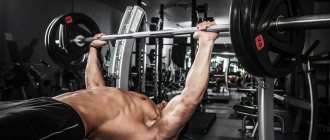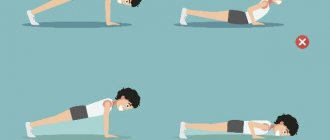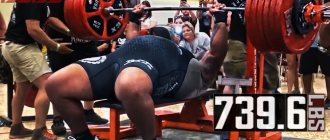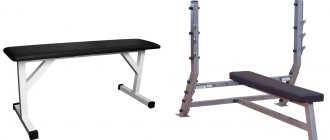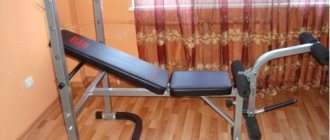Bench press strength training is an independent discipline for many athletes and the main indicator of the development of an athlete involved in bodybuilding and powerlifting. This is due to the fact that when performing heavy lifts of the barbell from a lying position, almost all the muscles of the body are trained.
With proper technique and regular exercise, both the upper and lower body will actively progress.
But still, most of the work will be done by the upper bundles of muscle fibers, which will make the athlete’s figure closer to ideal over time.
Training to improve the bench press is aimed at strengthening the areas that are actively involved in making the main effort.
When standard, basic approaches are no longer enough, you have to take on tightening your arms, back, legs, and rear deltoid muscles.
How to train
The bench press is a basic exercise. This suggests that the load is distributed over a large number of muscle groups, in this case the lion's share falls on the chest, shoulders and triceps. Therefore, in addition to exhausting training, you need to try to restore well.
A training program to increase your bench press should consist of at least two workouts per week.
A break of 2-3 days will be enough to restore creatine reserves and heal microdamages.
To progress as quickly as possible, you need to constantly complicate the task.
Every 4 weeks you need to determine your maximum, which you raise no more than once. To do this, ask a friend to back you up during the execution.
Using the data obtained, create a bench press training scheme in which the number of repetitions of the main exercise will be no more than five per approach. To do this you need to use 70-90% of the maximum weight.
Do at least 5 approaches of the main exercise, on which all available reserves of physical and psychological energy should be concentrated.
You should not think about further exercises, they are not needed, only the bench press is important, since that is what you are focused on, and it will bring the desired result.
After the main goal has been achieved, you can do a few secondary exercises to finish off the working muscles.
Techniques for Heavy Basic Movements
Different methods are used for different categories.
Approaches for the maximum number of repetitions with certain percentages.
I borrowed this method from Jim Wendler. Percentages are calculated from a “clean” (performed technically correctly) 1RM.
However, there should not be a complete refusal. If you feel that you probably won’t be able to complete the next repetition, it’s time to stop. The program uses a 3-week wave, in which the load increases by 2.5% each week. Then we take a step back and over the next 3 weeks we increase the load again:
- Week 1: 85%
- Week 2: 87.5%
- Week 3: 90%
- Week 4: 87.5%
- Week 5: 90%
- Week 6: 92.5%
- Week 7: 90%
- Week 8: 92.5%
- Week 9: 95%
- Week 10: 92.5%
- Week 11: 95%
- Week 12: 97.5%
Note: If you decide to continue with this program after 12 weeks, retest your 1RM and start a new cycle with the adjusted weights.
Strength-Skill Approaches
This method involves increasing the volume of load with non-maximum weights. Its main goal is to increase the efficiency of the nervous system. Every repetition must be perfect. You need to do several working sets with fairly heavy weights (82.5% - 87.5% of 1RM), but do not take any of them to failure. To make your sets more effective, focus on technique and speed in the concentric phase of the movements.
A 3-week wave is also used here, however, the intensity of the load does not change - its volume changes. After three weeks, we increase the intensity and reduce the load volume:
- Week 1: 82.5% 5 x 2
- Week 2: 82.5% 5 x 3
- Week 3: 82.5% 5 x 4
- Week 4: 85% 5 x 2
- Week 5: 85% 5 x 3
- Week 6: 85% 5 x 4
- Week 7: 87.5% 5 x 2
- Week 8: 87.5% 5 x 3
- Week 9: 87.5% 5 x 4
- Week 10: 90% 5 x 2
- Week 11: 90% 5 x 3
- Week 12: 90% 5 x 4
Note: If after 12 weeks you decide to continue with this program, retest your 1RM and start a new cycle with the adjusted numbers.
When calculating the weight of the weight for pull-ups, you need to take into account your body weight. If you weigh 90 kg and the maximum weight you can do is 20 kg, then your total weight will be 110 kg. 82.5% of this value is approximately equal to 91 kg, i.e. you will need to use 1 kg as a weight. If you try to calculate 82.5% from 20 kg, it comes out to 16 kg, which is too much for the intended load volume.
Rest/Pause for Assistance Exercises - For working sets, use a weight that you can perform 4-6 reps with. With this weight, you will perform as many technical reps as you can. Then multiply that number by two to get your total target number of reps for the rest/pause set. To complete it, you will need several short rest breaks.
For example, you did 5 reps in the first segment. This means the total should be 10. After the first 5 repetitions, rest for 15 seconds. Then do, say, 3 more. That leaves 2 reps. Rest another 15 seconds and then perform the last 2 reps.
In this video, Anthony Campbell demonstrates the rest/pause approach:
Assistive exercises
When a person reaches their peak performance, it can be due to several factors.
The best result will be if you have reached your genetic limit, which takes a lot of time to overcome.
But sometimes it is impossible to achieve the maximum because some muscle group is too weak, and additional load is placed on a stronger group.
On the one hand, this is good, because by pulling up the lagging group, you will noticeably improve the performance.
If you're stuck at a certain weight and don't know how to increase your bench press, try resting for 5 minutes after completing the basic exercise and doing a few additional sets.
Additional exercise program:
- Dumbbell flyes 15X4.
- Dips on parallel bars maximum X3.
- Pull-ups with a straight narrow grip 10x4.
- French press 12X4.
- Kettlebell swings 20X4.
- Push-ups maximum X3.
You need to do no more than two additional exercises per workout.
In addition, you can start training the intermediate stages. So, professional powerlifters, when they reach their maximum, begin to train stalling in the bench press, and slow execution.
Thanks to this, it becomes possible to work out the most difficult stage of the exercise.
Bench press mistakes
- Exercising the pectoral muscles too often and putting too much strain on the working muscles. You simply do not allow yourself to recover and each time you drive your muscles into an even greater recovery process until overwork sets in.
- Bench to failure in every workout, every time like the last. Most likely you don’t have a clear plan, you don’t know what periodization is, and you haven’t heard about the cycle at all.
- Training only around the bench press. You forget to exercise your legs or back. But thanks to them, you can increase the working weight in the bench press.
- Using an open grip, you only need to drop the barbell on your chest once to quit the gym forever.
- The chest press, with heavy weights, you won’t even be able to lift the barbell off your chest.
The role of periodization
When doing strength training with iron, many athletes divide their program into periods. This allows you to change the mode of action and the direction of the load, which has a positive effect on the results and psychological state of the athlete.
Thus, Sarychev’s bench press training is focused on ensuring that he can perform one maximum jerk at the appropriate time.
This is achieved by competent analytical work of coaches and splitting of loads.
Training program to increase bench press
For powerlifters, the bench press is a separate discipline, and in bodybuilding, the bench press is one of the most popular. Increasing its effectiveness guarantees the maximum effect from training and the achievement of the goals set for the athlete.
This can be achieved by performing the exercise in low repetitions. There are other movements that need to be performed to maximize the benefits you get from the barbell press. They must also be included in classes.
The program that allowed the champion to lift more than 300 kg
First day:
- Barbell press 5X12.
- Squat 5X5.
- Dumbbell flyes 15X4.
- Pull-ups 50 times.
Second day:
- Deadlift 5X5.
- Pull-ups with weight 15X4.
- Push-ups 100 times.
- Bars 50 times.
The third day:
- Heavy bench press 5X5.
- Dumbbell press 5X5.
- Stretching.
Please note that on the first day Kirill performs the exercise with an average weight, allowing him to do up to 12 repetitions.
This prepares the muscles for the fact that in the third workout it will mercilessly destroy this muscle group.
In addition, he remembers to do the rest of the basic sets, which makes his body evenly developed.
And this is interesting...
In the life of every person, events can occur that will motivate him to various feats, or, on the contrary, they can suppress a person. The main thing is perception. How does this apply to the bench press? Yes, very simple! Using the example of the life of Ryan Keneally, who was born in a small town and led an unhealthy lifestyle. He didn’t want to study, he was kicked out of baseball, basketball and football teams. And only when he paid attention to such an exercise as the bench press, his life began to change for the better. He chose a regular gym to start with, and it was love at first bench press. Since then, he has only increased his abilities, set goals, and improved his results.
Ryan Keneally is the man whose world record has stood since 2008. What conclusion can be drawn from this? It is not necessary to choose an idol and strive for its results; it is enough to simply love what you do and constantly improve. Find new methods to improve your bench press.
Useful tips
Increasing the results in this exercise will not only allow you to evenly develop the upper body and give it an aesthetic appearance, but will also increase your performance when working on other muscle groups.
Therefore, to achieve maximum rapid progress, you need to use all available opportunities. Kirill provides recommendations on how to make the training more professional.
The first thing to do, no matter what muscle group the efforts are directed at, or what results the athlete expects, is to keep a training diary.
It contains all the necessary information regarding the lesson plan. This will allow you to analyze your progress in the future and make useful changes.
In order to recover faster and improve the nervous connection between the muscles and the brain, it is advisable to train three times a week at the same time.
Thanks to this, the body will be able to adapt to the athlete’s schedule and release more hormones and glucose during exercise.
When performing a push, the back should arch into an arc, which is supported by the feet and shoulder blades of the athlete. This allows you to engage a large number of muscle groups and lift maximum weight.
Therefore, if a person has never trained seriously before performing the bench press, training the bridge without weight can improve the technique.
Don't forget about other basic exercises. They allow you to make your entire body stronger, which helps increase your bench press results.
If the goal of training is to increase working weight, then it is strength training. Therefore, there is no need to rush before performing the next repetition.
Muscles and nerves need a break to store energy.
Professional powerlifters spend 3 hours in the gym training one bench press. This is due to the fact that they are gathering their thoughts before the next difficult approach. Give yourself time to catch your breath for 2-3 minutes.
(Bench Press) High Intensity System
Article outline:
1. Analysis of a high-intensity system.
2. Designing a workout (microcycling).
3. Modification of the VI system.
4. Cycling (macrocycling).
5. Drawing up a training program using the VI system.
Preface.
A must read: Basics of Strength Training.
The high-intensity – low-volume training system (hereinafter referred to as HI) occupies not the last place among training programs. I assume that this style of training evolved from the training regimens of Ivan Abadzhiev, an outstanding Bulgarian coach who led the Bulgarian team to the team weightlifting championship in 72 at the Olympic Games. But Soviet weightlifting programs and training systems also made a major contribution to the development of high-intensity training regimens.
Before starting the analysis of the VI system, it should be noted that almost all preparation systems in the pre-competition period are similar to the VI system, but here the VI system will be considered not in the pre-competition period, but in the preparatory period.
From the author: It should be noted that I am not a fan of high-intensity training, but most powerlifting programs are designed according to this system. It should also be noted that almost all outstanding coaches of our time: ZTU V.S. Naleykin – coach of the Ukrainian national team in PL, ZTU L.V. Kotedzhi, ZTR S.V. Ivanov, the coach of the Russian national team in the PL, and many others, train using high-intensity schemes. All these people have trained many world champions and record holders, so there is no point in doubting the effectiveness of such programs.
1.
Analysis of a high-intensity system.
Basic principles inherent in the VI system.
- Low training volume.
- High UOI.
- High intensity.
- Average number of general preparatory exercises.
- A minimum number of special preparatory exercises.
- The progression of loads manifests itself more in intensity than in volume.
Analysis:
- Volume
- In the VI training program, the volume is extremely small, rarely goes beyond 100 KPS, or even less.
- Intensity:
always more than 80%, often training goes beyond 90% intensity. The OI is always greater than 70%. SVI - sometimes falls less than 70%, only in cases where there are a lot of warm-up approaches and very few KPS at high intensity.
- Reps:
Basic rep range is 2-4. More than 4 repetitions are extremely rarely used.
- Approaches:
Usually there are very few approaches, no more than 4-5, this is due to the enormous intensity.
- Load distribution across training days:
The load is distributed T+L+T, but most often – T+T. But due to the low volume, the athlete has enough time to recover.
- Distribution of the load in the exercise by approach:
The load is distributed according to classic layouts (2x2, 3x3, 4x4, etc.), which have long proven their effectiveness.
2. Designing a workout (microcycling).
Hard workouts:
KPSh and intensity lies within:
- 20-35 KPSh at UOI 70-80%
- 15-25 KPSh at UOI 80-85%
- 8-15 KPSh with CVI >85%
Heavy training in a 4x4 layout and 85% peak intensity:
| control | int | podkh | repeat | kpsh | kpsh general | UOI |
| squat | 4 | 4 | 16 | |||
| bench press | 60% | 1 | 4 | 4 | 4 | 2,4 |
| 69% | 1 | 4 | 4 | 4 | 2,76 | |
| 77% | 1 | 4 | 4 | 4 | 3,08 | |
| 85% | 4 | 4 | 16 | 16 | 13,6 | |
| dumbbell press | 4 | 5 | 20 | |||
| bitz pcs standing | 4 | 8 | 32 | |||
| 28 | 96 | 21,84 | 78% |
Total: KPSh – 28 Total KPSh – 96 UOI – 78% Peak layout 85% 4x4
Heavy training in a 3x3 layout and 90% peak intensity:
| control | int | podkh | repeat | kpsh | kpsh general | UOI |
| bench press | 60% | 1 | 4 | 4 | 4 | 2,4 |
| 72% | 1 | 3 | 3 | 3 | 2,16 | |
| 82% | 1 | 3 | 3 | 3 | 2,46 | |
| 90% | 3 | 3 | 9 | 9 | 8,1 | |
| narrow press | 3 | 3 | 9 | 9 | ||
| trits block | 4 | 8 | 32 | 32 | ||
| pull-ups | 4 | 8 | 32 | 32 | ||
| 19 | 92 | 15,12 | 80% |
Total: KPSh – 19 Total KPSh – 92 UOI – 80% Peak layout 90% 3x3
Let’s combine two days into a weekly microcycle: KPS – 47 Total KPS – 188 ROI – 79% 2 workouts with peak layouts 85% 4x4 and 90% 3x3
Conclusion: This program is a classic representative of VI training systems. This conclusion can be made based on two peak layouts (85% 4x4 and 90% 3x3), KPS (47), UOI (79%), which fully meet all the criteria of VI systems.
3. Modification of the VI system.
The classic VI system should be modified very carefully. If you make mistakes when modifying high-volume or medium-volume, this will lead to overtraining or stopping progress. In the VI system, most likely, this will lead to injury, this is due to the fact that all training takes place at enormous intensity, where the slightest shortcomings can result in injury.
It is generally not advisable to carry out highly repetitive and volumetric training in a VI system, since they completely contradict all principles. But, speed training does not contradict the principles of the classical VI system, therefore, only they will be considered.
Speed workouts:
This type of training can be included in the training process to improve or maintain speed. It is better to place these workouts closer to competitions or athletes who have a low projectile speed. In a CC training program, you can include medium and heavy layouts in the training program. If the recovery is properly structured and observed, they will not disrupt the training process in the VI system.
An example of a workout with an emphasis on developing or maintaining speed (quickness) in a heavy layout:
| control | int | podkh | repeat | kpsh | kpsh general | UOI |
| explosive spin | 10 | 1 | 10 | |||
| bench press with rubber bands | 60% | 1 | 3 | 3 | 3 | |
| 70% | 3 | 3 | 9 | 9 | ||
| 75% | 4 | 2 | 8 | 8 | ||
| triceps dumbbell | 4 | 5 | 20 | |||
| bitz pcs standing | 4 | 8 | 32 | |||
| 20 | 82 | 71% |
KPS – 20 General KPS – 82 UOI – 71%
Conclusion: If the athlete can cope with high speed (which is necessary for training speed), then this layout fully meets all the criteria for constructing a VI system. It should be noted that 71% is a relatively low intensity for a viscointensive system, but it must be taken into account that the rods still have rubber on them, which further increases the weight. Accordingly, the weight of the bar with rubber will be more than 71% of the maximum maximum.
4. Cycling (macrocycling).
In this example, consider a load distribution of 2 days (Heavy plus Heavy).
Cycling - variable (sinusoidal) - according to CPS and intensity.
| H1 | control | int | podkh | repeat | kpsh | kpsh general | UOI |
| Mon | bench press | 60% | 1 | 4 | 4 | 4 | |
| 70% | 1 | 3 | 3 | 3 | |||
| 78% | 2 | 3 | 6 | 6 | |||
| 85% | 3 | 3 | 9 | 9 | |||
| close grip press | 4 | 4 | 16 | ||||
| trits block | 4 | 6 | 24 | ||||
| latissimus | 4 | 8 | 32 | ||||
| 22 | 94 | 77% | |||||
| Fri | bench press | 60% | 1 | 4 | 4 | 4 | |
| 68% | 2 | 3 | 6 | 6 | |||
| 75% | 2 | 3 | 6 | 6 | |||
| 80% | 2 | 4 | 8 | 8 | |||
| seated press | 4 | 6 | 24 | ||||
| trits block | 3 | 8 | 24 | ||||
| Wed delts | 3 | 10 | 30 | ||||
| 24 | 102 | 72% | |||||
| 46 | 196 | 74% | |||||
| H2 | control | int | podkh | repeat | kpsh | kpsh general | UOI |
| Mon | bench press | 60% | 1 | 3 | 3 | 3 | |
| 70% | 1 | 3 | 3 | 3 | |||
| 80% | 2 | 3 | 6 | 6 | |||
| 90% | 2 | 2 | 4 | 4 | |||
| bench press narrow | 4 | 3 | 12 | ||||
| trits block | 3 | 8 | 24 | ||||
| bitz block | 3 | 10 | 30 | ||||
| 16 | 82 | 77% | |||||
| PT | bench press | 60% | 1 | 3 | 3 | 3 | |
| 68% | 1 | 3 | 3 | 3 | |||
| 75% | 2 | 3 | 6 | 6 | |||
| 80% | 4 | 3 | 12 | 12 | |||
| incline press | 4 | 4 | 16 | ||||
| trits block | 3 | 8 | 24 | ||||
| rear delts | 3 | 10 | 30 | ||||
| 24 | 94 | 75% | |||||
| 40 | 176 | 76% | |||||
| H3 | control | int | podkh | repeat | kpsh | kpsh general | UOI |
| Mon | bench press | 60% | 1 | 4 | 4 | 4 | |
| 70% | 3 | 3 | 9 | 9 | |||
| 75% | 3 | 3 | 9 | 9 | |||
| 80% | 3 | 3 | 9 | 9 | |||
| bench press narrow | 3 | 8 | 24 | ||||
| trits block | 3 | 8 | 24 | ||||
| latissimus | 3 | 8 | 24 | ||||
| 31 | 103 | 73% | |||||
| Fri | control | int | podkh | repeat | kpsh | kpsh general | UOI |
| bench press | 60% | 1 | 4 | 4 | 4 | ||
| 70% | 2 | 3 | 6 | 6 | |||
| 78% | 2 | 3 | 6 | 6 | |||
| 85% | 2 | 2 | 4 | 4 | |||
| seated press | 4 | 5 | 20 | ||||
| trits block | 3 | 8 | 24 | ||||
| Wed delts | 3 | 10 | 30 | ||||
| 20 | 94 | 73% | |||||
| 51 | 197 | 73% | |||||
| H4 | control | int | podkh | repeat | kpsh | kpsh general | UOI |
| Mon | bench press | 60% | 1 | 4 | 4 | 4 | |
| 70% | 1 | 3 | 3 | 3 | |||
| 80% | 1 | 3 | 3 | 3 | |||
| 85% | 3 | 3 | 9 | 9 | |||
| bench press narrow | 3 | 3 | 9 | ||||
| trits block | 3 | 8 | 24 | ||||
| bitz pcs | 3 | 8 | 24 | ||||
| 19 | 76 | 77% | |||||
| Fri | bench press | 60% | 1 | 3 | 3 | 3 | |
| 70% | 1 | 2 | 2 | 2 | |||
| 80% | 1 | 2 | 2 | 2 | |||
| 85% | 2 | 3 | 6 | 6 | |||
| 90% | 2 | 2 | 4 | 4 | |||
| bench press | 3 | 3 | 9 | ||||
| trits block | 3 | 8 | 24 | ||||
| rear delts | 3 | 10 | 30 | ||||
| 17 | 80 | 79% | |||||
| 36 | 156 | 78% |
KPS schedule:
UOI: About
general KPS:
Click on the picture to open it full screen.
5. Drawing up a training program using the VI system.
From the author: In the chapter “Cycling” there was a training program compiled by me. This chapter will describe how to create your own training program.
Goal Definition:
During the preparatory period, many goals can be achieved, while in the pre-competition period there is usually one goal - to reach the peak of strength in order to show the best result.
Goals of the preparatory period:
- Improving sports skills.
- Gaining muscle mass.
- Improvement of qualities (strength and/or speed).
- Elimination of dead spots (work on problem areas of amplitude).
In this example, we’ll look at how to build a training program for a person who sets 4 main goals:
- Improving technical skills;
- Improvement of qualities (strength);
- Elimination of the dead point (the dead point will be in boost);
- Gaining muscle mass.
From the author: Other dead points (start and middle) will be considered in other systems. As well as improving speed (working for speed).
- To improve sportsmanship, a large number of barbell lifts must be performed in a competitive exercise (hereinafter referred to as CC).
- To improve strength qualities, you need to perform volume with intensity, which will help the body adapt to this load and, accordingly, improve sports results.
- To eliminate problems with a dead center, special preparatory exercises (hereinafter referred to as SPT) should be used.
- To gain muscle mass, you should include general preparatory exercises (hereinafter referred to as GPE).
Exercise Set Definitions:
From the author: I selected the exercises myself, you can choose any exercises you like that you consider most effective.
- Bench press – SU. Helps develop strength qualities and improve sportsmanship.
- Bar press - SPU. Helps develop strength qualities and eliminate pressure problems.
- Squats are SL, but for a bencher it’s more like SL.
- Seated press - OPU. Promotes the development of muscles necessary in the control system (triceps and anterior deltoid muscles).
- Dumbbell press - OPU. Promotes the development of the muscles necessary for the control system (triceps, pectoral muscles and anterior deltoid muscles).
- Extension of arms on a block - OPU. Promotes the development of muscles necessary in the SU (triceps).
- Standing barbell curl - OPU. Promotes the development of stabilizer muscles (biceps).
- Removing the dumbbells to the sides - OPU. Promotes the development of stabilizer muscles (middle deltoid muscle).
- Pull-ups - OPU. Promotes the development of stabilizer muscles (latissimus muscles).
Definitions of the intensity zone, SV, KPS, repetitions in the approach:
From the author: Taking into account that this program will be formed according to the basic principles of high-intensity training, intensity, CV, KPS and repetitions will be set by this system.
- Intensity zone – 70-90%
- FEP zone: 70-80%
- KPS zone: Training - 8 - 35. Microcycle - 40-100.
- The repetition zone in the approach is 2-4.
Determining the number of training days and the nature of the training:
- Training days: 3 training days.
- Nature of training: Hard, medium and easy training.
From the author: Let's do a classic load distribution: Heavy, medium and light training.
Preparation of a training program:
| 1 Week | |||||||
| 1 workout - hard | |||||||
| control | int | podkh | repeat | kpsh | kpsh general | UOI | |
| 1 | bench press | 70% | 1 | 3 | 3 | 3 | |
| 75% | 1 | 3 | 3 | 3 | |||
| 80% | 2 | 3 | 6 | 6 | |||
| 85% | 3 | 3 | 9 | 9 | |||
| 2 | Bar press | 90,0% | 3 | 2 | 6 | 6 | |
| 3 | dumbbell press | 4 | 6 | 24 | |||
| 4 | arm extension on a block | 4 | 8 | 32 | |||
| 27 | 83 | 82% | |||||
| Workout 2 - medium | |||||||
| control | int | podkh | repeat | kpsh | kpsh general | UOI | |
| 1 | squats | 4 | 4 | 16 | |||
| 2 | bench press | 65% | 1 | 3 | 3 | 3 | |
| 70% | 1 | 3 | 3 | 3 | |||
| 75% | 3 | 2 | 6 | 6 | |||
| 80% | 3 | 2 | 6 | 6 | |||
| 3 | seated press | 4 | 4 | 16 | |||
| 4 | pull-ups | 3 | 8 | 24 | |||
| 5 | Wed delts | 3 | 8 | 24 | |||
| 18 | 98 | 74% | |||||
| Workout 3 – easy | |||||||
| control | int | podkh | repeat | kpsh | kpsh general | UOI | |
| 1 | bench press | 65% | 2 | 3 | 6 | 6 | |
| 70% | 2 | 3 | 6 | 6 | |||
| 75% | 3 | 3 | 9 | 9 | |||
| 2 | dumbbell press | 4 | 6 | 24 | |||
| 3 | arm extension on a block | 4 | 8 | 32 | |||
| 4 | barbell curl | 4 | 8 | 32 | |||
| 21 | 109 | 71% | |||||
| 66 | 290 | 76% | |||||
Analysis:
- Total KPS – 290.
- KPSH SU and SPU – 66.
- UOI SU and SUP – 76%
- Intensity – within 65% - 90%.
Conclusions:
The program is a classic representative of a high-intensity training system. All limits of intensity, KPS and UOI are observed.
From the author: This was just an example of creating a cycle; only one training week was described, because the topic of cycling was not touched upon when creating your own program. Cycling will be discussed in other articles.
Static exercises
It will be useful to work with static loads a couple of times a month. They can be performed on the same bench, only the bar needs to be firmly fixed to the racks.
Their benefit is to improve the functioning of joints and nerves.
The brain sends a signal to the muscles to lift the load, since it is fixed and does not move, the efforts will be applied more and more, reaching the maximum.
This is a great way to increase your strength. Static exercises can also be performed at home.
To do this, it is enough to try to push a wall, only a strong one, or push apart a door frame. But first you need to warm up your joints properly to avoid injury.
